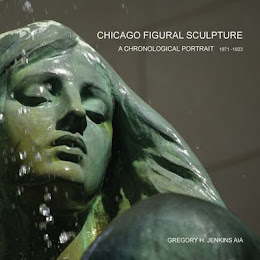"It does not prove a thing to be right because the majority say it is so." FRIEDRICH SCHILLER
I have been
fascinated by Richard Nickel's photographs of the Portrait Busts, taken just
prior to demolition at the Schiller
Building
RICHARD NICKEL PHOTOGRAPH
And even with a
little research, even more questions surface.
Who sculpted them? Who do they
depict? Reidy attributes the Busts to Richard
Bock. But Bock's autobiography, edited
by his daughter Dorothi mentions only the Schiller's interior tympanums. A later monograph by Chicago
Photographs
show twelve busts at the second floor with as many as 24 near the tower
cornice. (Some, of course, may have been duplicates.) And yet, I've only discovered 7 extant
(including the one I just learned of on Geneva Terrace). Where are the rest? Rumors abound. And speculation. Lot 's
of speculation.
So here's mine. (Why not?)
Almenraeder and Bock may well have worked on these portrait heads
together -- all the heads are good, but not stylistically consistent. (I'll
give the more Baroque "Engels" to Ecole trained, Bock.) Bock and Almenraeder were friends and both had simultaneous
formalized assignments on the Schiller
Building
Fritz Reuter
Yaakov Liebmann
Meyerbeer
Wolfgang Amadeus Mozart
Gotthold Ephram Lessing
And for the following two, I suggest these for your consideration:

Friedrich
Engels
Friedrich
Schiller
And for the
location of the remaining work? Richard
Nickel knows. Knows where every one of
them are. And is holding on to that
secret until he knows that these fragments of history and art will be
appreciated. And safe. Which may just be a very, very long time.
+
+++



































































